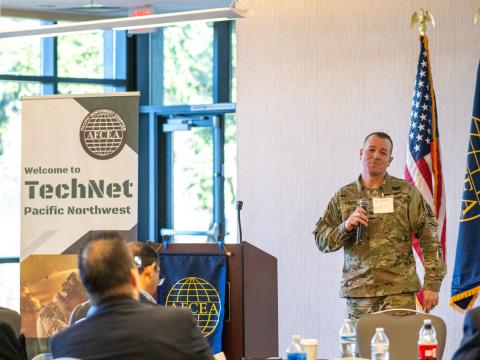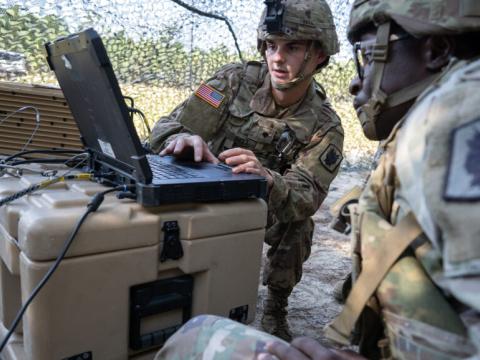Communications Systems Meld for Greater Synergy
Initiative examines a common core technology
The desire to produce a truly joint radio for airborne, maritime and fixed station users has led two separate acquisition programs to merge. By combining their efforts, program managers hope to streamline the bidding and procurement process while creating more efficient equipment.
Interoperability across all tactical communications systems is the goal of a U.S. Defense Department initiative to develop a family of software-defined radios. The devices will be able to operate all current U.S. military frequency formats while being flexible enough to accommodate new waveforms as they are introduced. By combining many radios into a single unit, warfighters and military vehicles will be freed from the burden of carrying multiple pieces of equipment. However, before these advantages are realized, some of the programs creating this new hardware may require structural changes.
The need for efficiency provided the impetus behind the merger of the Joint Tactical Radio System (JTRS) Cluster 3 maritime and fixed station and Cluster 4 airborne programs. Now known as Airborne, Maritime and Fixed Station (AMF) JTRS, the new effort began during interservice dialogues in early 2003. According to Lt. Col. Maryann Watson, USAF, AMF JTRS program manager, Hanscom Air Force Base, Massachusetts, discussions began when both projects were at the same point in the acquisition cycle. Because neither had yet entered into a formal contract stage, it was possible for the program managers and teams to discuss whether the programs were sufficiently unique to dictate separate acquisitions. A joint study by the Sarnoff and MITRE corporations and queries to industry firms regarding their views on the matter revealed substantial similarities between the two initiatives. “We determined that there really were some noticeable areas of commonality where there could be some redundancies if we kept the programs totally separate,” Col. Watson says.
The service acquisition executives in charge of the programs were then alerted about the study and the potential for a merger. In October, the two project teams met to determine the advantages of a partial merger against a single integrated program. Based on the teams’ recommendations, the service acquisition executives decided on a combined joint program.
Using the operational requirements document as a starting point, the teams identified the features shared by their programs. Of these, the key commonality was that the airborne and maritime and fixed station radios operate the same set of waveforms. “Based on that, our engineers looked at how likely it was that the radios would be designed differently in order to implement these functions. They determined that, at the design level, there was no reason that the designs should or would be different,” Col. Watson explains.
The primary differences between the sets will be more external than internal, centering on the packaging specific to the environment in which the devices will operate. The colonel notes that, even within the original airborne JTRS program, at least two kinds of packaging were required. One was a small form designed to fit in combat jets, whereas a larger version with more channel capacity was envisioned for command and control platforms such as Airborne Warning and Control System, Joint Surveillance Target Attack Radar System and multisensor command and control aircraft. “We already expected that there would be at least two form factors, if not more, on the airborne side. So the concept of needing some variation in the packaging was already apparent in our program. Merging Clusters 3 and 4 just leveraged that strategy and took it into the maritime domain,” she points out.
The union offers additional benefits through reduced logistics costs and increased production efficiencies by eliminating redundancies. Although the external packaging may differ, the internal core radio system will probably be common for all versions. Another redundancy was present in contract selection and award methods. When both programs were separate, the cluster managers each had to award two contracts for early designs and then reduce that to a single contractor for the final selection. The colonel adds that the merger reduced this from four to two contract teams, creating a more efficient program management infrastructure.
A common core radio design also will enhance the sets’ overall interoperability and usefulness to the intended customer base. “In a sense, it’s a bigger program from the point of view of who our customers are. We now have both airborne users and more warfighters as well as maritime and fixed station operators. We want to make sure that our strategy satisfies all of them. Rather than sacrificing priorities, we expect that the strategy will enable us to meet a broader range of needs,” Col. Watson says.
To reflect the truly joint nature of AMF JTRS, the U.S. Navy, which administered Cluster 3, and the U.S. Air Force, which managed Cluster 4, will share the management of the new program. Col. Watson explains that the program currently is overseen by the Navy program executive officer (PEO) for command, control, communications, computers and intelligence and space in San Diego. The current structure has a Navy deputy program manager and an Air Force deputy PEO and reports to the Air Force service acquisition executive. When the leadership roles switch, each of these positions will be filled by a member of the opposite service, she says.
The program begins with a 15-month pre-system development and demonstration (SDD) phase followed by an SDD phase for critical design and testing. This initial stage focuses on system architectures and preliminary designs for the AMF JTRS units. It will identify cost-effective hardware and software commonalities in both operating domains. A request for proposal issued in January 2004 requires proposals by mid-February. This will begin a source selection process that is scheduled to conclude toward the end of April.
Col. Watson notes that, when the merger was officially announced, all contracts for Clusters 3 and 4 were formally canceled, which permitted industry to form new teams. The program held an industry day in December to obtain feedback from the commercial sector about the merger. She adds that the response was positive in favor of combining the two programs.
The merger has changed the scope of the program, the colonel says. She notes that the Cluster 3 contract not only included a JTRS set but also an integration kit. The airborne Cluster 4 contract dealt with only the radio kits, but because of how the Navy managed the maritime program, it was considered a turnkey operation that included the integration kits.
One of the challenges of the AMF JTRS program is to bring together experts from the different teams and familiarize them with each other’s work. “Over the next few months, we will be morphing the entire team into folks that are aware of both the maritime and airborne parts of the program. So that’s really our challenge in the near term—to broaden the perspective of each of the team members,” she explains.
Although this will not turn airborne radio engineers into maritime communications experts, it will serve to broaden their knowledge of the subject, the colonel says. This also is not the first time that two service programs have been merged into a joint effort, she adds, citing the examples of the joint tactical information distribution system and multifunction information distribution system programs. These were both legacy efforts that provided radio frequency solutions for airborne and maritime domains.
Besides gathering technical experts, AMF JTRS formed a virtual program office to share technical information. The site permits various team elements, such as system engineers located in Charleston, South Carolina, who were supporting the Cluster 3 maritime and fixed station team, to share data with their airborne cluster colleagues. This online structure also serves to link the program research facilities in Massachusetts and San Diego.
Additional information on the Airborne, Maritime and Fixed Joint Tactical Radio System is available on the World Wide Web at http://www.hanscom.af.mil.




Comments